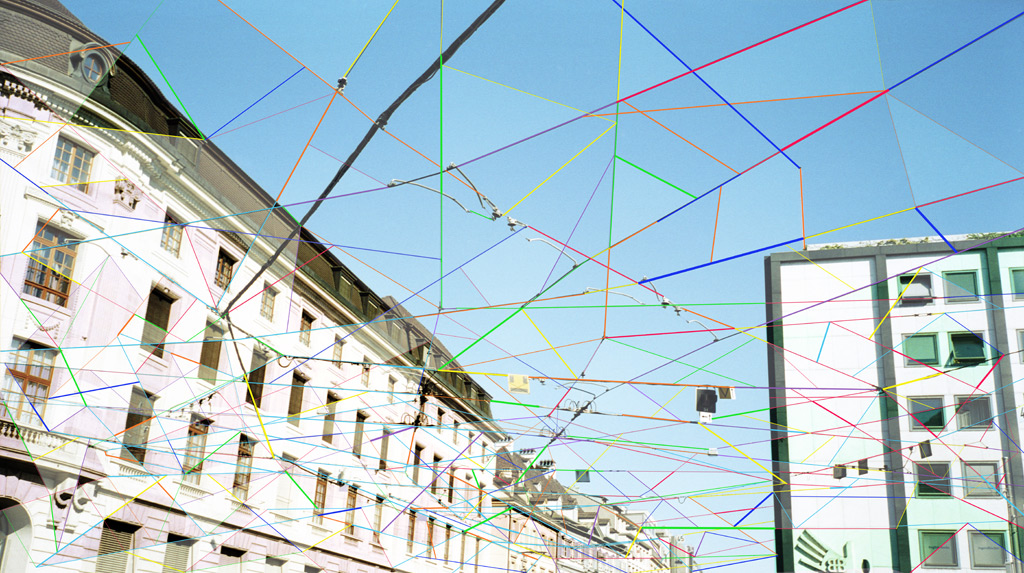Variations on the Network
For human beings of the 21st century, the idea that everything is networked, whether socially, biologically, or digitally, seems all but self-evident. So thoroughly does the idea condition our perceptions of ourselves and the world that it is taken for granted. In her installations, drawings, and photography, Marie-Josée Laframboise draws our attention to a relational universe weaving through the world, and, having made us aware of it, invites us to look at it anew. In one photograph, for instance—Sky Over Basel (2004)—she captures the interlocking grid of countless electric and phone cables that we no longer take notice of as they criss-cross the space above our heads. Besides vividly capturing extended networks whose very existence surprises us, these images, in their treatment of the subject, reveal the geometric fragments that the lines delineate and divide, sectioning the space into sets—in the mathematical sense—relationships that have always fascinated Laframboise. Sensitive to such relational connections, the artist is continuously reinventing and transforming them in her works, her rearrangements sometimes underlining the organic and biological dimensions of the network, sometimes the more virtual and abstract.

Patiently tying strips of kraft paper together, Laframboise created large installations of tentacular lacing attached to columns, tree branches, or walls. Invading their respective space, such installations as String Bridge (1998) and Nets (2000) recall bundles of lianas, or neurones, that catch and keep one’s gaze. The exhibition space plays a central role in articulating the installation, as in String Bridge, where our attention is drawn at once to that which is connected and that which connects. This attention to the context of the works’ spatial disposition applies to all of the artist’s installations as she appropriates the space by taking advantage of its singularities, as in The Weeping Willow (2001, 2009), which vertically juxtaposes an assemblage of strips of cloth that hangs from the ceiling and a pool of marbles spread, like tears, on the floor beneath.
Generally, the scenography Laframboise proposes tends toward abstraction. This is particularly evident in installations made up of netting stretched between the walls of a gallery or between buildings (To Catch Emptiness, 2011); here, the suggestion of a network recalls the world of projection-mapping, that is, of virtual modelling. What I find especially striking in these diaphanous, etherial, “reticular sets”, which may also suggest the shimmering play of the northern lights, is a sustained tension. In the assemblages of silk and nylon thread that form Foul-ups and Small Shambles (2005, 2009), this tension seems to rest on a more haphazard organization. The title can be misleading, however: the networking here posits an underlying logic, which it is left to the spectator to identify; as is also the case for the small colour tubes affixed to the wall in Circuits (2003, 2009, among others), of which only a portion appear to be visible. One part of the system is shown while the other is only implied, in an arrangement that suggests a massive electronic motherboard.

In her Inflections series (2013-14), Laframboise chose to detach the work from the walls in order to occupy the entire gallery space with serried fragments of colourful hoops. Their assemblage forms a set of monumental, though very light, circumvolutions that create a movement in the space in which viewers entering the exhibition take part. Akin to Blue Variations (2013) by their intersecting curves, whose geometric nature confirms the artist’s penchant for giving a playful turn to the scientific models that inspire her, these Inflections are truly three-dimensional.
A remarkable apprehension of the world and of space is proposed in drawings that are based on geographical maps, of which the artist reinvents the contours in Grand Course (2012). Taking advantage of language and mapping characteristics, this journey provides a series of layered, interconnected abstract sets and circuits.
At the very heart of the body of work that Marie-Josée Laframboise has given us over the years is a creative gesture that is constantly varied and remodulated. In this creative process, the transformation of often simple materials gives rise to complex assemblages, their playful bent immediately apparent, not to speak of the poetry emanating from these works as they explore and toy with space while proposing a great many imaginative variations on the idea of the network.
Jean-Philippe Beaulieu, 2015.
